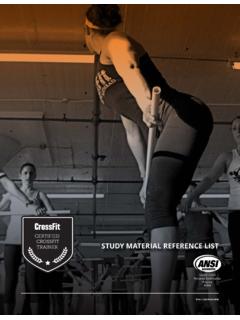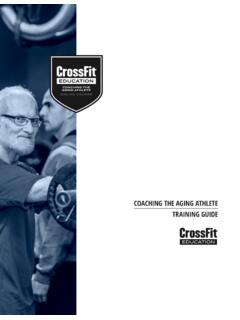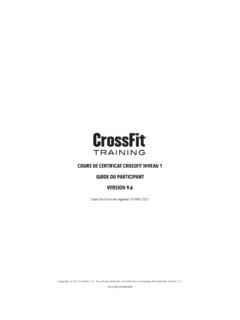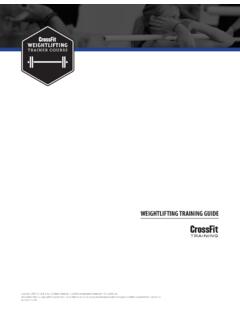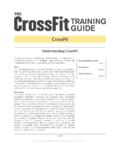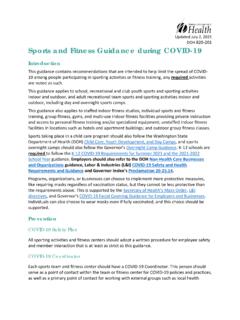Transcription of GYMNASTICS TRAINING GUIDE - CrossFit
1 Copyright 2015 CrossFit , Inc. All Rights Reserved. CrossFit is a registered trademark of CrossFit , Inc. All content herein is Copyright CrossFit , Inc. No content, in part or in whole, may be reproduced without prior written consent from CrossFit , TRAINING GUIDE2 of 53 Copyright 2015 CrossFit , Inc. All Rights OF CONTENTSCOURSE OVERVIEW..3 WHAT IS GYMNASTICS ? ..4 WHY DO WE DO IT? ..6 CrossFit GYMNASTICS TERMINOLOGY ..8 UNDERSTANDING SKILL PROGRESSION..9 SPOTTING ..10 WHY DO WE SPOT? ..10 WHAT TO LOOK FOR WHILE SPOTTING ..10 GRIP..11 SHOULDERS ..13 COURSE MOVEMENTS ..15 HOLLOW AND ARCH POSITIONS ..15 PULL-UP ..17 KNEE-TO-ELBOW AND TOE-TO-BAR ..19 BALL-UP ..21 PASS THROUGH ..22 FRONT LEVER ..22 BACK LEVER ..23 RING SUPPORT ..24 IRON-CROSS ..24 DIP ..25 MUSCLE-UP ..26 PISTOLS ..29 HANDSTANDS ..31 HANDSTAND PUSH-UP ..33 HANDSTAND WALK ..33 HEADSTAND ..34 HAND BALANCE ..34 PARALLETTES.
2 35 RING AUXILIARY DRILLS ..36 PROGRAMMING ..37 GYMNASTICS & TUMBLING ..41A MESSAGE FROM TUCKER ..51 GYMNASTICS TRAINING GUIDE |3 of 53 Copyright 2015 CrossFit , Inc. All Rights CrossFit GYMNASTICS course was developed by Coach Jeff Tucker and is taught by his team of instructors. The goal is to empower you as a coach and student of seminar is designed to educate coaches about basic GYMNASTICS movements. Understanding and practice of these movements with proper form undoubtedly helps athletes progress and improve their general physical have different goals. For some, the goal is to live a more comfortable and health-ier life. Others might have jobs in which their lives and the lives of others depend on their physical abilities. Some athletes simply want to dominate workouts. Regardless of the goal, the skills, drills, and concepts in this course, basic or otherwise, allow all athletes to improve in a safe and effective manner.
3 We want and expect coaches to become very comfortable with a variety of movements. We want them to understand how to break them down, to see and correct movement faults, and to be able to use a variety of spotting encourage coaches to keep an open mind, ask questions, and approach the weekend with an adventurous attitude. GYMNASTICS TRAINING GUIDE |COURSE OVERVIEW4 of 53 Copyright 2015 CrossFit , Inc. All Rights IS GYMNASTICS ?TYPES OF GYMNASTICST here are many types of GYMNASTICS , with artistic GYMNASTICS being the classic style seen at the Olympics. Women contest four events: vault, uneven bars, beam, and floor. Men contest six events: vault, high bar, pommels, rings, parallel bars, and movements. Done with or without GYMNASTICS genre is acrobatic GYMNASTICS . More people understand this as the crazy stuff seen in Cirque du Soleil and other similar shows. Trapeze, straps or ribbons, random balancing acts, and trampolines are just some of the elements in acrobatic gym-nastics.
4 Rhythmic GYMNASTICS use items including ribbons, batons, balls, and movements can also be found in other places: the sport has influence on various types of stunt work used in movies or various live HISTORYThe origin of GYMNASTICS dates back to antiquity. The Greeks and Romans were propo-nents of GYMNASTICS and used GYMNASTICS TRAINING to prepare their military forces for the physical demands of combat. For instance, GYMNASTICS can help a soldier master skills such as mounting and dismounting horses. In addition to military TRAINING , GYMNASTICS move-ments were used to provide GYMNASTICS appeared in the 18th century, when two physical educators decided to create apparatus such as the high bar and parallel bars (originally fashioned from a ladder with the rungs removed). A pommel was turned sideways and the handles were removed to create the apparatus needed to vault. GYMNASTICS TRAINING GUIDE |COURSE OVERVIEW5 of 53 Copyright 2015 CrossFit , Inc.
5 All Rights s GYMNASTICS was eventually accepted into the modern Olympic Games in 1896, and women were welcomed in Navy adopted GYMNASTICS in 1942 as a way to make naval aviators fearless and to give them better spatial awareness. The 101st Airborne Division of the Army later used the Navy s GUIDE to GYMNASTICS and tumbling in order to develop agility, balance, strength, and confidence in soldiers. When CrossFit Founder and CEO Greg Glassman reintroduced this piece of literature to the public in the February 2005 CrossFit Journal article GYMNASTICS and Tumbling, copies were difficult to find, so the entire GUIDE was scanned and made available to the community. It can be found later in this IS CrossFit GYMNASTICS ?In CrossFit , body-weight movements are considered GYMNASTICS ( , air squat, push-up, pull-up, etc.). We are taking skills from the sport of GYMNASTICS and applying them to workouts. In CrossFit , the GYMNASTICS label is applied any exercise in which you move your body through a range of motion (ROM) or extended range of motion (EROM) without an external load.
6 Isometric holds are also considered uses short parallel bars ( parallettes ), the floor, still rings, pull-up bars, dip bars, climbing ropes, and other equipment to implement GYMNASTICS establishes functional capacity for body control and range of TRAINING GUIDE |COURSE OVERVIEW6 of 53 Copyright 2015 CrossFit , Inc. All Rights DO WE DO IT? GYMNASTICS is one of the three foundational modalities of CrossFit . If GYMNASTICS movements are performed properly, they influence every aspect of your life and have a dramatic effect on your fitness. GYMNASTICS assist in development of many of the 10 components of fitness: accuracy, agility, balance, coordination, cardiovascular endurance, flexibility, power, speed, strength, and stamina. Nothing beats GYMNASTICS in terms of develop-ing the four neurological components of the 10: coordination, agility, balance, and accuracy. Furthermore, GYMNASTICS TRAINING produces impressive strength gains without requiring an exter-nal is a cornerstone of CrossFit , along with weight-lifting and monostructural metabolic- conditioning (or just monostructural ) movements.
7 It is an essential element in the Theoretical Hierarchy of Development of an athlete, the CrossFit pyramid (see What Is Fitness? ). The hierarchy reflects foundational dependency and time ordering of development as follows: nutrition, cardiovascular efficiency, body control, exter-nal-object control, and sport-specific application. According to the hierarchy, you can only maximize competency in one cat-egory if you have laid the foundation in the category before it. This hierarchy puts a larger emphasis on GYMNASTICS proficiency body control before weight TRAINING and FOR GYMNASTICS From Used with a plural verb: Physical exercises used to develop and display strength, balance, and agility. Especially those performed on or with with a singular verb: The art or practice of such use of the term GYMNASTICS not only includes the competitive Olympic sport but also activities in which the aim is body con-trol climbing, yoga, calisthenics, and dance, for TRAINING GUIDE |COURSE OVERVIEW7 of 53 Copyright 2015 CrossFit , Inc.
8 All Rights is required for proper form, and proper form is required to demonstrate body control. As such, GYMNASTICS has a clear emphasis on strength in body-weight move-ments. More than anything else, strict form establishes mastery in a movement, and for this reason we promote strict movement before we apply momentum. The strength gains from mastering the strict movements are well worth the effort, and the possibility of injury is reduced substantially when strict movements are practiced first. Small moves will bring great rewards. You do not rush these movements. You learn them and earn them! GYMNASTICS TRAINING GUIDE |COURSE OVERVIEW8 of 53 Copyright 2015 CrossFit , Inc. All Rights GYMNASTICS TERMINOLOGYA ctive Tissue.. Muscles that do work even during transitional .. A position used to create stability, characterized by strong midline contraction with active tissue from toes to .. Movement absent a kip.
9 The athlete relies on muscle control and strength to complete the .. A dynamic movement from a lower plane to a higher .. The forces created while body weight is in .. Musculature that ranges from the top of the glutes up to the traps, including the front, back, and sides of the torso but excluding the .. The manner or method of doing a movement correctly while striving for Apparatus .. Stable and does not move (floor and bars).Dynamic Apparatus .. Unstable and moves (rings).Skill Set .. TRAINING for form and strength before going for .. Movement around a Flexibility .. Contracting opposing muscles to stretch or hold a Flexibility .. Stretching a muscle that does not require contraction of opposing .. Range of .. Extended range of .. Giving assistance to an athlete if needed as part of a progression or in order to prevent is imperative for proper TRAINING GUIDE |COURSE OVERVIEW9 of 53 Copyright 2015 CrossFit , Inc.
10 All Rights introducing new skills or working toward a particular skill, the coach should always question whether the athlete is strong enough. Always demand strength, strength, and more strength. Also consider the mobility and flexibility of the athlete. Are certain areas restricting proper movement or position? If strength and mobility are in line, determine if the athlete needs work on spatial awareness or coordination. These are the basic require-ments of skill , strength, and more terms of development of movement, there are some basic rules to follow. Always use static apparatus before dynamic apparatus (with occasional exceptions when scaling loads). Opt for strict movement before adding momentum to the movement whenever possible. It is true that some movements can only be learned by applying momentum, but prerequisite strength must be established long before ever attempting any such , CONSISTENCY, THEN INTENSITYK ipping movement allows for higher power output, which is directly related to intensity.
